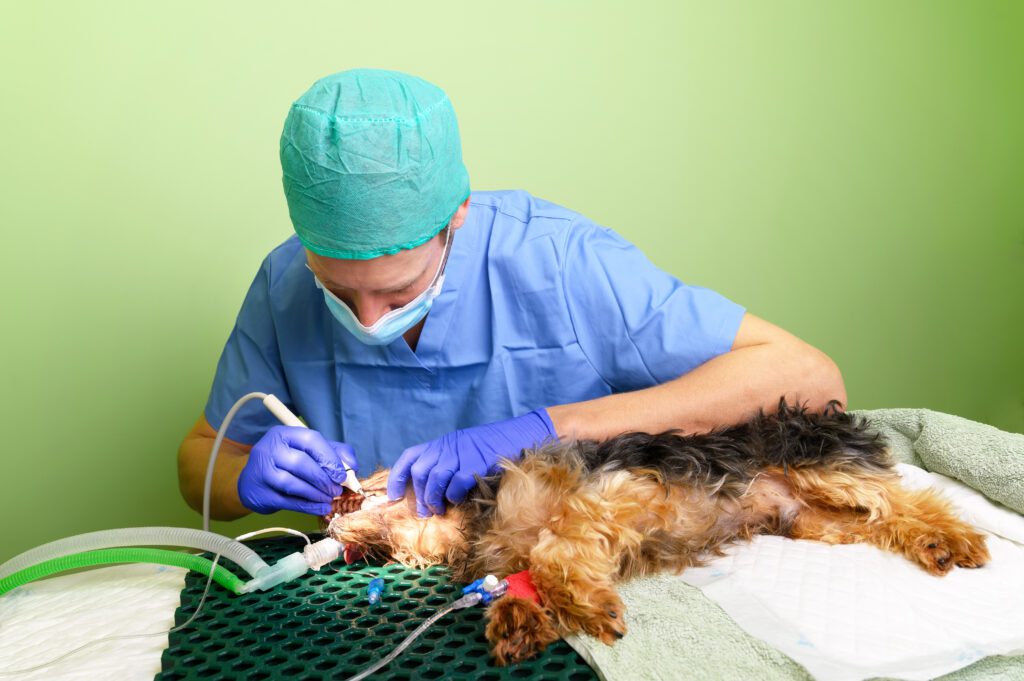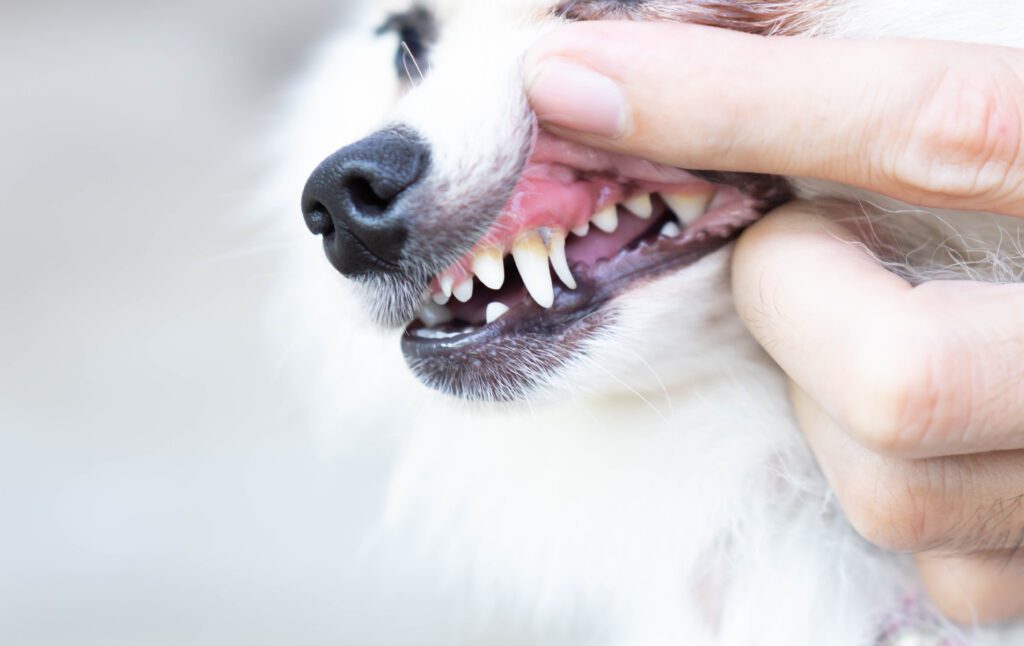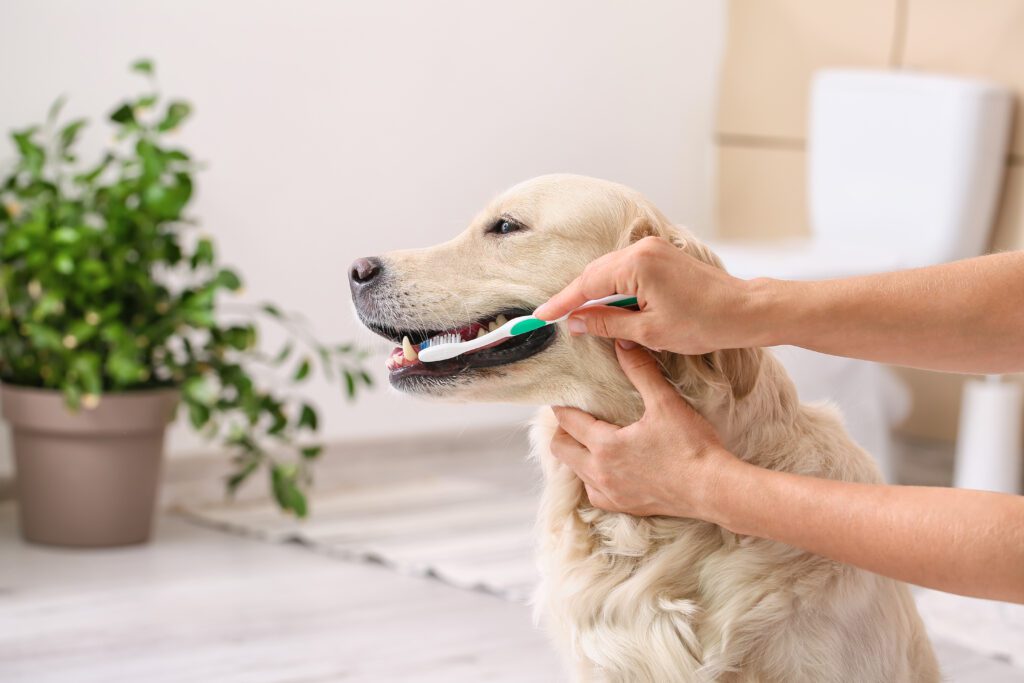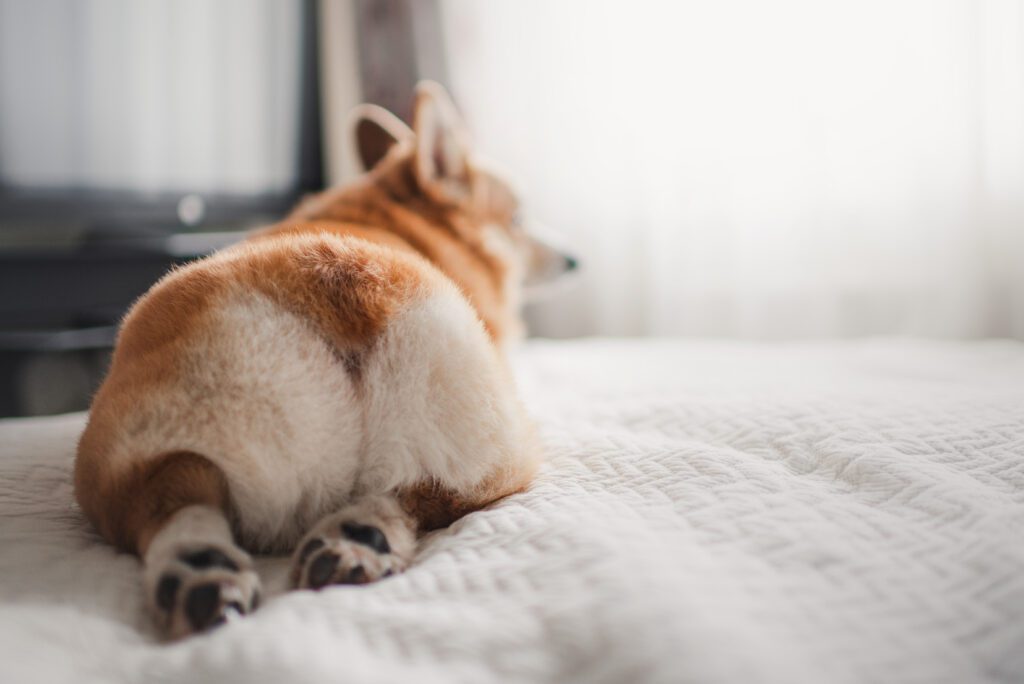“As if she had eaten a turd.”
“Was it that bad?”
“It made the whole house stink, we had to open the windows. In December,” says Joris, the owner of Honda, a seven-year-old English cocker spaniel.
Honda suffered from plaque and tartar. This caused gum inflammation and smelly breath. Joris tried all the remedies he could find online. From dental sticks to fresh mint. He even made his own toothpaste for Honda. But nothing helped. Most products only disguised the bad smell.
“What really helps against stinky dog breath in the long term?” Joris asked himself.
“Time for a fact check,” thought vet Veronique. She investigated to see which natural ingredients really work against bad breath and which do not. In this article we share the results.
But you must know this first:
Your dog’s mouth is a favourite place for bacteria. It is warm and humid, and when they eat, the bacteria sit on the front teeth waiting for the food. After they have had their fill, they also need to go to the toilet. They simply do that in your dog’s mouth.
These waste products stick to your dog’s teeth (dental plaque). They accumulate in hard-to-reach places, such as in the safe gap between the tooth and the gum, and between molars. The more plaque your dog has, the stronger the smell. If you don’t do anything about it, the plaque will calcify and form tartar: the ideal breeding ground for even more plaque, and therefore even more bad odours. So before we tackle the plaque, we must first remove the tartar.
Tartar is an ideal breeding ground for bacteria. They not only cause odours, they are also very unhealthy for your dog. They cause all kinds of problems, both inside and outside the mouth.
Plaque causes painful inflammation, which affects the tooth root and can cause your dog to lose teeth.
Toothaches, dental problems and too many bad bacteria in the mouth can lead to digestive problems, coughs and laryngitis. There are even bacteria that cross the mouth barrier and enter the body. They then cause problems with your dog’s joints, heart and kidneys.
So a healthy dog starts with a healthy mouth!
Unlike plaque, you cannot yourself remove tartar from your dog’s teeth. The vet has to do this with dental cleaning or détartrage. In addition to removing the tartar, the vet will also polish your dog’s teeth which leaves them with a nice shiny coat and making it harder for bacteria to attach themselves.
A dental cleaning is an easy but very annoying treatment for your dog. Therefore, it is usually done under general anaesthesia.

Once all the tartar has been removed, you should continue to maintain your dog’s teeth. In other words, you must prevent plaque from accumulating. You do this by brushing your dog’s teeth regularly.
Tip: Brush your dog’s teeth from an early age, as it is more difficult to teach your dog this later on.

Vet Véronique looked into which ingredients really work against bad breath. These are the winners:

Activated carbon is used to make poisons harmless, but did you know that it also neutralises foul odours? With its highly absorbent effect, it attract s bacteria and dirt like a magnet.
But it not so easy to convince your dog to rinse its mouth with activated carbon. “That’s why we at Dog Chef secretly dream of a toothpaste for dogs that combines all the benefits of the winning ingredients based on our research,” says Véronique.
We dream of a dog toothpaste that combines all the benefits of the best ingredients against plaque and bad odours – Véronique Van Haegenborgh, veterinarian and nutritionist at Dog Chef
Bentonite is a type of clay that was first discovered in Benton, America. The special absorption power of this clay attracts harmful bacteria and plaque, causing them to come lose from the teeth and removed through saliva. In addition ,bentonite also contains minerals that naturally strengthen tooth enamel.
Calcium carbonate is an indispensable ingredient for making your own dog toothpaste. It whitens teeth and thickens liquids. The abrasive particles brighten tooth enamel, but to avoid excessive wear it is best not to use too much of it. A good toothpaste contains 30 to 50% abrasive.
Coconut oil is a natural ingredient with a powerful antimicrobial effect. It is made up of 50% lauric acid, which kills harmful oral bacteria. Just think of the bacteria Streptococcus mutans that causes tooth decay, stinking breath and gum disease. In addition, it also provides a smooth layer on the teeth so that bacteria are less able to attach themselves.
Swallowing coconut oil is not a problem and it supports your dog’s digestion and immune response. It also gives your dog healthy skin, a shiny coat and supple joints. Best of all? Your dog will love it!
Tip: As most dogs are fond of coconut oil, it is the ideal ingredient to use to help your dog get used to having its teeth brushed. Put half a teaspoon of coconut oil on a toothbrush and let your dog lick it off .

Another natural product that should not be missing from the ideal dog toothpaste is aloe vera gel or powder. Due to its antibacterial effect, aloe veraprevents stinky breath. It also has an anti-inflammatory effect, helping to prevent gum inflammation and tooth loss .
It is not a problem if your dog swallows some aloe vera while its teeth are brushed. It contains several vitamins, including vitamin A, C, E and B. And it is rich in minerals, such as phosphorus, magnesium, calcium, iron, zinc, copper, chromium, sodium and potassium. This is good for a stronger immune system, a healthier blood sugar level and a smoother digestion.
However, do not allow your dog to swallow large quantities of aloe vera, as this may give him a stomach ache.
The acid in lemon juice has a corrosive effect on plaque. It removes stains and whitens teeth. It also kills the bacteria that cause bad breath.
If you are going to make your own dog toothpaste, it is good to know that lemon juice is also a natural conversation starter. It ensures that other natural ingredients in your toothpaste spoil less.
Tip: Never use more than a squeeze of lemon juice as too much acid causes wear on the teeth. Also, most dogs are not really fond of sour flavours.
Silicon comes in the form of a fine white powder. It is tasteless and does not dissolve in water. That means it can act well as an abrasive in homemade toothpaste. Silicon also thickens your toothpaste and prevents lumps.
Manuka honey comes from the Manuka bush in New Zealand. This special honey is known for its strong antibacterial effect. Research shows that Manuka honey can dissolve mucous microorganisms such as plaque. Most dogs also really like it. That makes manuka honey a powerful tool in the fight against stinky breath.
Parsley has a natural antibacterial effect. It kills the plaque bacteria that cause foul breath andyou don’t even need to make your own toothpaste to benefit from it; just a sprinkle of parsley in the food will help your dog’s breath smell better.
Just as with ike parsley and lemon , sage kills bacteria that are responsible for bad smells in your dog’s mouth. Sage also has an anti-inflammatory effect, which helps to prevent the spread of infections. Sage protects your dog against gingivitis and periodontal disease.
Propolis is a resinous substance produced by bees. It has a yellow to dark brown colour. Bees use it to seal holes and crevices in the hive to keep out enemies. This bee glue has been used since ancient times for its medicinal properties. The Romans used it to heal wounds faster, the Incas to relieve fever and pharaohs to reduce toothache.
Modern scientists have discovered that propolis contains an antifungal agent: pinocembrin. Propolis and pinocembrin are still used successfully in the treatment of burns, acne, eczema, colds, flu, fever, coughs.
Propolis in toothpaste helps against:
Knotted wrack or Ascophyllum nodosum is a natural seaweed, available as a powder. Research shows that dogs given snacks containing knotted wrack powder have healthier teeth than those given a placebo. They suffer less from plaque, gingivitis and smelly breath.
Sodium bicarbonate, also known as baking soda, is a great natural alternative to artificial abrasives in toothpaste:
Sodium bicarbonate was for a while discouraged as a toothpaste because it would damage tooth enamel, but new research shows that the abrasive effect of sodium bicarbonate is no greater than that of commercial toothpastes.
Please note that a good toothpaste contains 30 to 50% abrasive agents. More than that would be bad for the tooth enamel. No need to soak the toothbrush in the sodium bicarbonate jar!
Many toothpastes contain enzymes from whey protein (glucose oxidase and lactoperoxidase). They soften the plaque, making it easier to remove. But did you know that your dog also makes these kinds of enzymes itself? They are released through the saliva while chewing. You can stimulate this process with a chew toy. Our favourite is a chew toy made from deer antlers.



Votre navigateur est obsolète!
Mettez à jour votre navigateur pour afficher correctement ce site Web. Download Google Chrome